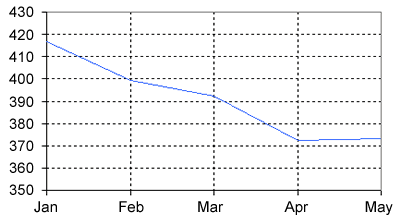Line graphs
Comparing two related variables
Multiple line graphs
Line graphs are more popular than all other graphs combined because their visual characteristics reveal data trends clearly and these graphs are easy to create. Line graphs, especially useful in the fields of statistics and science, are one of the most common tools used to present data.
A line graph is a visual comparison of how two variables—shown on the x- and y-axes—are related or vary with each other. It shows related information by drawing a continuous line between all the points on a grid. For information on the shapes of line graphs, see the Organizing data chapter.
Line graphs compare two variables: one is plotted along the x-axis (horizontal) and the other along the y-axis (vertical). The y-axis in a line graph usually indicates quantity (e.g., dollars, litres) or percentage, while the horizontal x-axis often measures units of time. As a result, the line graph is often viewed as a time series graph. For example, if you wanted to graph the height of a baseball pitch over time, you could measure the time variable along the x-axis, and the height along the y-axis.
Although they do not present specific data as well as tables do, line graphs are able to show relationships more clearly than tables do. Line graphs can also depict multiple series which are usually the best candidate for time series data and frequency distribution.
Bar and column graphs and line graphs share a similar purpose. The column graph, however, reveals a change in magnitude, whereas the line graph is used to show a change in direction.
In summary, line graphs
- show specific values of data well
- reveal trends and relationships between data
- compare trends in different groups of a variable
Graphs can give a distorted image of the data. If inconsistent scales on the axes of a line graph force data to appear in a certain way, then a graph can even reveal a trend that is entirely different from the one intended. This means that the intervals between adjacent points along the axis may be dissimilar, or that the same data charted in two graphs using different scales will appear different.
Example 1 – Plotting a trend over time
Figure 1 shows one obvious trend, the fluctuation in the labour force from January to July. The number of students at Andrew's high school who are members of the labour force is scaled using intervals on the y-axis, while the time variable is plotted on the x-axis.
The number of students participating in the labour force was 252 in January, 252 in February, 255 in March, 256 in April, 282 in May, 290 in June and 319 in July. When examined further, the graph indicates that the labour force participation of these students was at a plateau for the first four months covered by the graph (January to April), and for the next three months (May to July) the number increased steadily.
Figure 1. Labour force participation in Andrew's high school

Example 2 – Comparing two related variables
Figure 2 is a single line graph comparing two items; in this instance, time is not a factor. The graph compares the number of dollars donated by the age of the donors. According to the trend in the graph, the older the donor, the more money he or she donates. The 17-year-old donors donate, on average, $84. For the 19-year-olds, the average donation increased by $26 to make the average donation of that age group $110.
Figure 2. Average number of dollars donated at Evergreen High School, by age of donor

Example 3 – Using correct scale
When drawing a line, it is important that you use the correct scale. Otherwise, the line's shape can give readers the wrong impression about the data. Compare Figure 3 with Figure 4:
Figure 3. Number of guilty crime offenders, Grishamville

Figure 4. Number of guilty crime offenders, Grishamville

Using a scale of 350 to 430 (Figure 3) focuses on a small range of values. It does not accurately depict the trend in guilty crime offenders between January and May since it exaggerates that trend and does not relate it to the bigger picture. However, choosing a scale of 0 to 450 (Figure 4) better displays how small the decline in the number of guilty crime offenders really was.
Example 4 – Multiple line graphs
A multiple line graph can effectively compare similar items over the same period of time (Figure 5).
Figure 5. Cell phone use in Anytowne, 1996 to 2002

Figure 5 is an example of a very good graph. The message is clearly stated in the title, and each of the line graphs is properly labelled. It is easy to see from this graph that the total cell phone use has been rising steadily since 1996, except for a two-year period (1999 and 2000) where the numbers drop slightly. The pattern of use for women and men seems to be quite similar with very small discrepancies between them.
| Next section |
Navigation and search
Note: This page contains several navigation menus. To enhance accessibility, most of these menus and the site search box are grouped in this section.
To find out more about accessibility features on our site, read our accessibility page.

